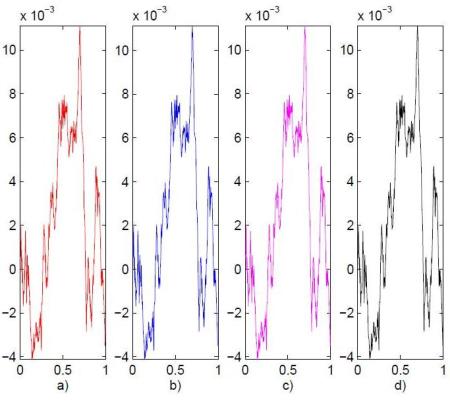A mathematical proof of existence of a stochastic process involving fractional exponents seemed out of question after some mathematicians claimed this cannot exist. This observation is strongly linked to the current definition and may undergo revision if nature does not agree with it. Stochastic processes are very easy to simulate on a computer. Very few lines of code can decide if something works or not. I and Alfonso Farina, together with Matteo Sedehi, have introduced the idea that the square root of a Wiener process yields the Schroedinger equation (see here or download a preprint here). This implies that one has to attach a meaning to the equation
In a paper appeared today on arxiv (see here) we finally have provided this proof: We were right. The idea is to solve such an equation by numerical methods. These methods are themselves a proof of existence. We used the Euler-Maruyama method, the simplest one and we compared the results as shown in the following figure

a) Original Brownian motion. b) Same but squaring the formula for the square root. c) Formula of the square root taken as a stochastic equation. d) Same from the stochastic equation in this post.
There is now way to distinguish each other and the original Brownian motion is completely recovered by taking the square of the square root process computed in three different ways. Each one of these completely supports the conclusions we have drawn in our published paper. You can find the code to recover this figure in our arxiv paper. It is obtained by a Monte Carlo simulation with 10000 independent paths. You can play with it changing the parameters as you like.
This paper has an important consequence: Our current mathematical understanding of stochastic processes should be properly extended to account for our results. As a by-product, we have shown how, using Pauli matrices, this idea can be generalized to include spin introducing a new class of stochastic processes in a Clifford algebra.
In conclusion, we would like to remember that, it does not matter what your mathematical definition could be, a stochastic process is always a well-defined entity on a numerical ground. Tests can be easily performed as we proved here.
Farina, A., Frasca, M., & Sedehi, M. (2013). Solving Schrödinger equation via Tartaglia/Pascal triangle: a possible link between stochastic processing and quantum mechanics Signal, Image and Video Processing, 8 (1), 27-37 DOI: 10.1007/s11760-013-0473-y
Marco Frasca, & Alfonso Farina (2014). Numerical proof of existence of fractional Wiener processes arXiv arXiv: 1403.1075v1



 Posted by mfrasca
Posted by mfrasca 
